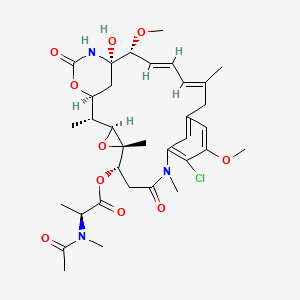| MeSH term | MeSH ID | Detail |
|---|---|---|
| Breast Neoplasms | D001943 | 24 associated lipids |
| Lung Neoplasms | D008175 | 171 associated lipids |
| Pancreatic Neoplasms | D010190 | 77 associated lipids |
| Colonic Neoplasms | D003110 | 161 associated lipids |
| Mammary Neoplasms, Experimental | D008325 | 67 associated lipids |
| Body Weight | D001835 | 333 associated lipids |
| Prostatic Neoplasms | D011471 | 126 associated lipids |
| Melanoma | D008545 | 69 associated lipids |
| Brain Diseases | D001927 | 27 associated lipids |
| Leukemia P388 | D007941 | 43 associated lipids |
MAYTANSINE
MAYTANSINE is a lipid of Polyketides (PK) class. Maytansine is associated with abnormalities such as Myelosuppression and BOSLEY-SALIH-ALORAINY SYNDROME. The involved functions are known as Mutation, Agent, Polymerization, Cell Cycle Arrest and Drug Kinetics. Maytansine often locates in Cytoplasm, Hepatic, Lysosomes, Cell surface and Microtubules. The associated genes with MAYTANSINE are ABCB1 gene, HM13 gene, CNN1 gene, CYP2C8 gene and CYP2D6 gene. The related lipids are Valerates. The related experimental models are Xenograft Model.
Cross Reference
Introduction
To understand associated biological information of MAYTANSINE, we collected biological information of abnormalities, associated pathways, cellular/molecular locations, biological functions, related genes/proteins, lipids and common seen animal/experimental models with organized paragraphs from literatures.
What diseases are associated with MAYTANSINE?
MAYTANSINE is suspected in Myelosuppression, BOSLEY-SALIH-ALORAINY SYNDROME and other diseases in descending order of the highest number of associated sentences.
Related references are mostly published in these journals:
| Disease | Cross reference | Weighted score | Related literature |
|---|
Possible diseases from mapped MeSH terms on references
We collected disease MeSH terms mapped to the references associated with MAYTANSINE
PubChem Associated disorders and diseases
What pathways are associated with MAYTANSINE
There are no associated biomedical information in the current reference collection.
PubChem Biomolecular Interactions and Pathways
Link to PubChem Biomolecular Interactions and PathwaysWhat cellular locations are associated with MAYTANSINE?
Visualization in cellular structure
Associated locations are in red color. Not associated locations are in black.
Related references are published most in these journals:
| Location | Cross reference | Weighted score | Related literatures |
|---|
What functions are associated with MAYTANSINE?
Related references are published most in these journals:
| Function | Cross reference | Weighted score | Related literatures |
|---|
What lipids are associated with MAYTANSINE?
Related references are published most in these journals:
| Lipid concept | Cross reference | Weighted score | Related literatures |
|---|
What genes are associated with MAYTANSINE?
Related references are published most in these journals:
| Gene | Cross reference | Weighted score | Related literatures |
|---|
What common seen animal models are associated with MAYTANSINE?
Xenograft Model
Xenograft Model are used in the study 'IMGN853, a Folate Receptor-α (FRα)-Targeting Antibody-Drug Conjugate, Exhibits Potent Targeted Antitumor Activity against FRα-Expressing Tumors.' (Ab O et al., 2015).
Related references are published most in these journals:
| Model | Cross reference | Weighted score | Related literatures |
|---|
NCBI Entrez Crosslinks
All references with MAYTANSINE
Download all related citations| Authors | Title | Published | Journal | PubMed Link |
|---|---|---|---|---|
| Liang Y et al. | A Nanosystem of Amphiphilic Oligopeptide-Drug Conjugate Actualizing Both αvβ3 Targeting and Reduction-Triggered Release for Maytansinoid. | 2017 | Theranostics | pmid:28900511 |
| Khot A et al. | Development of a Translational Physiologically Based Pharmacokinetic Model for Antibody-Drug Conjugates: a Case Study with T-DM1. | 2017 | AAPS J | pmid:28808917 |
| Menderes G et al. | SYD985, a Novel Duocarmycin-Based HER2-Targeting Antibody-Drug Conjugate, Shows Antitumor Activity in Uterine and Ovarian Carcinosarcoma with HER2/Neu Expression. | 2017 | Clin. Cancer Res. | pmid:28679774 |
| Montemurro F | Trastuzumab emtansine in HER2-positive metastatic breast cancer. | 2017 | Lancet Oncol. | pmid:28526537 |
| RÃos-Luci C et al. | Resistance to the Antibody-Drug Conjugate T-DM1 Is Based in a Reduction in Lysosomal Proteolytic Activity. | 2017 | Cancer Res. | pmid:28687619 |
| Harbeck N et al. | De-Escalation Strategies in Human Epidermal Growth Factor Receptor 2 (HER2)-Positive Early Breast Cancer (BC): Final Analysis of the West German Study Group Adjuvant Dynamic Marker-Adjusted Personalized Therapy Trial Optimizing Risk Assessment and Therapy Response Prediction in Early BC HER2- and Hormone Receptor-Positive Phase II Randomized Trial-Efficacy, Safety, and Predictive Markers for 12 Weeks of Neoadjuvant Trastuzumab Emtansine With or Without Endocrine Therapy (ET) Versus Trastuzumab Plus ET. | 2017 | J. Clin. Oncol. | pmid:28682681 |
| Takegawa N et al. | DS-8201a, a new HER2-targeting antibody-drug conjugate incorporating a novel DNA topoisomerase I inhibitor, overcomes HER2-positive gastric cancer T-DM1 resistance. | 2017 | Int. J. Cancer | pmid:28677116 |
| Mescher C et al. | Left Ventricular Ejection Fraction Screening and Clinical Decision-making in Metastatic HER2-positive Breast Cancer. | 2017 | Anticancer Res. | pmid:28668870 |
| Tumey LN and Han S | ADME Considerations for the Development of Biopharmaceutical Conjugates Using Cleavable Linkers. | 2017 | Curr Top Med Chem | pmid:29357803 |
| Zhong P et al. | αβ integrin-targeted micellar mertansine prodrug effectively inhibits triple-negative breast cancer in vivo. | 2017 | Int J Nanomedicine | pmid:29138558 |
